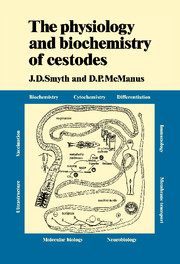Book contents
- Frontmatter
- Contents
- Preface
- Acknowledgements
- 1 The cestodes: general considerations
- 2 The adult cestode: special structural features relevant to its physiology
- 3 The adult cestode in its environment
- 4 The adult: general metabolism and chemical composition; lipid metabolism
- 5 The adult: carbohydrate metabolism
- 6 The adult: proteins and nucleic acids
- 7 The biology of the egg
- 8 Developmental biology of larvae
- 9 Development within definitive host
- 10 Cultivation of cestodes in vitro
- 11 Immunobiology of cestodes
- References
- Index
7 - The biology of the egg
Published online by Cambridge University Press: 24 November 2009
- Frontmatter
- Contents
- Preface
- Acknowledgements
- 1 The cestodes: general considerations
- 2 The adult cestode: special structural features relevant to its physiology
- 3 The adult cestode in its environment
- 4 The adult: general metabolism and chemical composition; lipid metabolism
- 5 The adult: carbohydrate metabolism
- 6 The adult: proteins and nucleic acids
- 7 The biology of the egg
- 8 Developmental biology of larvae
- 9 Development within definitive host
- 10 Cultivation of cestodes in vitro
- 11 Immunobiology of cestodes
- References
- Index
Summary
General account
The egg is essentially the only developmental stage (except a coracidium in certain orders) which is exposed to the external environment. A number of morphological and physiological adaptations allow the egg to survive in this hazardous environment – and at the same time respond sensitively to those stimuli which enable it to hatch in the appropriate place in the appropriate host.
Eggs can be divided into two groups: group I (p. 170), those from cestodes whose hosts have aquatic associations; and group II (p. 170), those whose hosts have terrestrial associations. The protective membranes developed in these two groups tend to be strikingly different. In group I, for example, the pseudophyllidean egg has a sclerotin (p. 172) capsule (Fig. 7.1(6)) and a ciliated embryophore, whereas in group II, the cyclophyllidean egg usually (Fig. 7.1 (a)) has a thick keratin embryophore and a thin capsule. In the Taeniidae the embryophore is made of closely fitting keratin blocks (Fig. 7.1(c)) which separate under the action of gut enzymes and allow the oncosphere to hatch (p. 191).
The egg and reproductive system thus present an elegant model for the study of a number of areas of physiological interest, especially the ultrastructure and cytochemistry of the spermatozoa, ova and embryonic envelopes (see p. 166), as well as the physiological processes involved in egg hatching and the subsequent ‘activation’ of the released oncosphere.
- Type
- Chapter
- Information
- The Physiology and Biochemistry of Cestodes , pp. 156 - 194Publisher: Cambridge University PressPrint publication year: 1989
- 1
- Cited by



